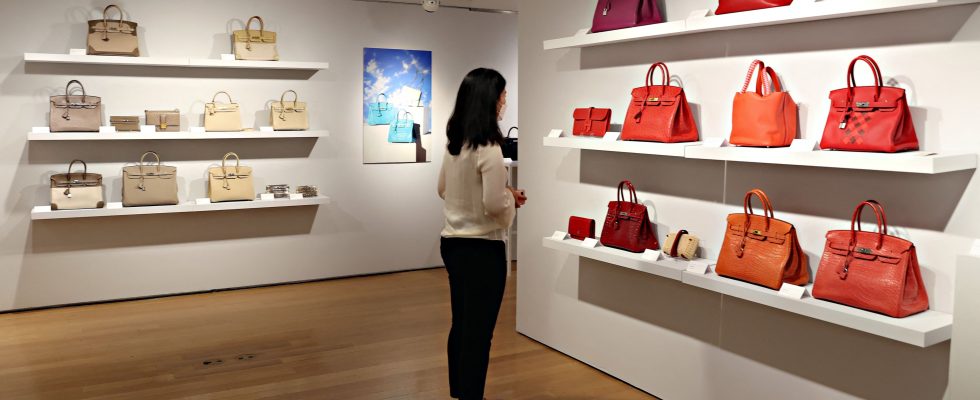At first glance, the black leather bag placed on Fiona Caliandro’s work table shows no defects. Its rounded and asymmetrical shape is recognizable at first glance: it is an almost perfect imitation of the Saddle model from the house of Christian Dior, imagined by the designer John Galliano in 1999 and currently offered at 3,800 euros on the brand’s website. This leather goods expert, who worked at several luxury houses before launching her own second-hand item consignment store, runs her hands over the leather for a long time, scrupulously detailing every detail. The material, exterior seams and metal parts of the object are so similar to the original that the authenticator admits having to work several hours before deciding on its true value. Especially since the handbag, left by a customer a few months ago for an appraisal after a purchase on an online peer-to-peer resale platform, is accompanied by an invoice from Dior, a credit card authentication, a box similar to those sold in stores, and a dust bag – fabric pouches to protect products from dust – flocked with the brand name. “Even the material of the box and the color of the logo are perfectly imitated,” explains Fiona Caliandro.
But certain details do not deceive the eye of this enthusiast. Inside the product, the typography of the numbers that make up the serial number “is a little too round.” Above all, they do not correspond to the date of purchase on the invoice: the number indicates that the bag was produced in 2018, for a purchase in a Cannes boutique in 2021. “Given the demand for this bag, it “It’s impossible for it to have remained in the sales circuit for so long. It should have been purchased in 2019, early 2020 maximum,” says the young woman. The fake authenticity card also raises questions. On the back, a Chinese character is missing in the translation of the certifications. “The house of Dior would never allow such a spelling mistake. It is a decisive signal,” she concludes.
Since the opening of its consignment store, More than a year ago, the expert has seen the interest in luxury second-hand items explode: from 10 to 15 products authenticated then resold each month last year, she is now responsible for appraising around a hundred items monthly. “Most of them are resold after a week, especially during this holiday season,” she emphasizes, while certain big brand bags are extremely coveted. Birkin or Kelly models from Hermès, for which customers must be placed on a waiting list in store, can thus achieve a higher second-hand sale price than in store. “Bought for 8,000 euros, a Kelly bag can be resold for 15,000 on the Internet the next day. It’s a real investment,” explains the expert.
“Superfakes”
Such a business obviously attracts counterfeiters. In addition to her consignment business, Fiona Caliandro welcomes many customers keen to authenticate luxury products – bags, small leather goods or shoes – purchased on online resale sites. For a price ranging from 60 to 200 euros, it allows them to remove doubts about the quality of their new accessory. Result ? “Approximately 80% of the products that these customers present to me are fakes, sometimes very well imitated and resold for several thousand euros. These are what we call super-fakes,” laments the authenticator. During their meeting with the expert, some customers learn that they have paid more than 1,000 euros for a faux leather Chanel bag or 2,000 euros for the famous counterfeit Dior Saddle bag.
To counter counterfeiters, the major online resale platforms have decided to react. Since October 2023, Vinted has launched a new authentication service for its French customers, based in Hamburg and made up of 17 experts. To ensure the authenticity of the coveted products, buyers pay ten euros. If the item is identified as counterfeit, it will be returned to the seller, who will then be unable to put it up for sale again on the platform. “We have also put in place certain measures which can result in the permanent blocking of the accounts of sellers who repeatedly ignore our policy by publishing counterfeit articles,” explains Cécile Wickman, Senior Luxury Director at Vinted, to L’Express. The problem is widely taken seriously by its teams: even before the implementation of this verification service, it specifies that 2.6 million counterfeits have been deleted on Vinted in 2022.
These fake items are “more and more professional, of better quality and more and more sophisticated,” explains Björn Holzhauer, a Vinted expert based in Hamburg. “Today, only experts can distinguish good plagiarism from an authentic article,” he assures. At Catawiki, an online auction platform specializing in the purchase and sale of luxury items, Jennifer Lumbroso confirms: an expert in leather goods, she indicates “failing two lots out of ten” offered by professional or private sellers. Counterfeiting is no longer concentrated only on the most classic brands, like Chanel, Louis Vuitton, Yves Saint Laurent or Hermès, but also on more recent designers like Jacquemus, or “streetwear” products like Yeezy sneakers – which can reach several hundred euros per pair.
The differences are sometimes tiny: recently, Jennifer Lumbroso refused an Hermès bag for sale by analyzing the size of the studs located at the bottom of the bag, which measured “one to two millimeters more than on the original bag”. But the specialist wants to reassure customers: most often, authentication is carried out at first glance: “Forgers never manage to bring together all the codes or quality criteria of the big houses. There are so many points to check that there will always be something wrong.”
.
